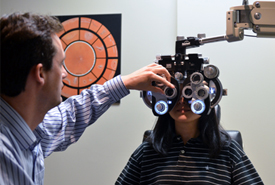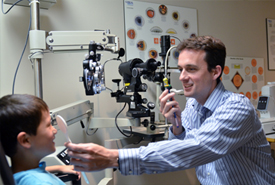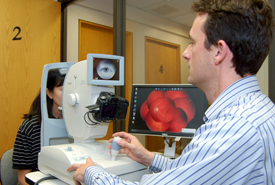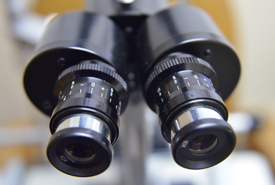Eye examination
Doctors of Optometry play an essential and ongoing role in ensuring the health of you and your family.
We diagnose, treat and help prevent diseases and disorders affecting the visual system, the eye and related structures. We also assist in identifying general health conditions that are often first detected through an eye exam, provide referrals to specialists and can help manage post-eye-surgery health. From infants to grade-schoolers through to grandparents, Doctors of Optometry not only ensure quality of vision and eye health, but quality of life.
As Doctors of Optometry, we evaluate many factors that can affect your vision and eye health. We review your case history, conduct an external and internal exam of your eyes, and measure vision qualities, such as eye movements and coordination , sharpness of vision and peripheral vision. We also evaluate your ability to adjust focus, and to see colour and depth normally. If we detect problems, we may recommend glasses, contact lenses, exercises, medication or surgery.
Many serious eye conditions don’t have obvious symptoms. Some eye diseases only show symptoms when the condition is advanced and difficult, or even impossible, to treat. A comprehensive eye exam provides the full assurance of vision and eye health that a store sight test or a school vision screening cannot. A sight test can only determine a lens power by relying on a combination of computerized tests using automated equipment. These automated sight tests are not comprehensive or accurate and do nothing to determine if your eyes are healthy.
Your vision is priceless. Routine eye exams by a Doctor of Optometry not only ensure good vision and eye health, but peace of mind.
Eye Health & Exam Frequency



Infants (six months or younger):
Newborns have all the ocular structures necessary to see, although these are not yet fully developed. At birth, your baby can see blurred patterns of light and dark.
During the first four months, their visual horizon will expand from a few centimetres to many metres. Their vision will become clearer and colour vision will begin to develop. Their two eyes will start working together. By four months of age, an infant’s colour vision is similar to an adult’s, and by the sixth month, your baby will acquire eye movement control and develop eye-hand coordination skills.
For the first six months, an infant’s eyes can appear slightly crossed or out of alignment, but this is usually normal. But if your infant’s eyes appear significantly crossed or remain misaligned after six months of age, contact your Doctor of Optometry right away. Your child may have strabismus, commonly known as crossed eyes, a condition that needs to be treated with eyeglasses, contact lenses, prisms and/or vision therapy and, in some cases, surgery. In time, if not corrected, the ignored eye will become unable to function normally and will become largely unused. This may result in the development of lazy eye.
Lazy eye, or amblyopia, is another condition that becomes apparent within the first six months of your baby’s life. This condition describes weak vision or vision loss in one eye as a result of an uncorrected prescription. If detected or treated before eight years of age, it will often resolve completely. It’s important to treat amblyopia early – with vision therapy, eyeglasses and/or contact lenses, or patching – as treatment becomes very difficult later on. Untreated, amblyopia can lead to blindness in the affected eye.
Visual abilities play a big role in early development. Doctors of Optometry recommend infants have their first eye exam between six and nine months of age. Children should have at least one eye exam between the ages of two and five, and yearly after starting school. A Doctor of Optometry can complete an eye exam even if your child doesn’t know their ABCs. A Doctor of Optometry can use shapes, pictures and other child-friendly ways to evaluate vision and eye health.



Preschoolers:
Between ages one and two, it’s important for a child to develop good hand-eye coordination and depth perception.
There are activities that can help improve these essential visual skills, such as playing with building blocks or balls of any shape and size.
Children at age two enjoy listening to and telling stories. It helps them develop visualization skills and prepares them for learning to read. At this stage of their development, toddlers also like to paint, draw and colour, sort shapes and sizes, and fit or assemble pieces. These activities are all integral to their visual development.
A preschooler’s eyes are not ready for prolonged or intense concentration at short distances, but they do enjoy TV. To make TV viewing easier on the eyes, the room should be softly lit, the television placed to avoid glare, and the child should sit further away than five times the screen’s width, taking periodic breaks from staring at the screen.
Be alert for symptoms that may indicate your child has a visual problem:
- red, itchy or watering eyes
- sensitivity to light
- an eye that consistently turns in or out
- squinting, rubbing the eyes, or excessive blinking
- a lack of concentration
- covering or closing one eye
- irritability or short attention span
- holding objects too close
- avoiding books and television
- visible frustration or grimacing
Protect your child’s vision. If you notice any of these symptoms, book an eye exam with a Doctor of Optometry. Your child should have a complete optometric eye exam between six and nine months of age. Children should have at least one eye exam between the ages of two and five, and yearly after starting school.
School-age children:
A school-age child’s eyes are constantly in use in the classroom and at play. For school-age children, several different visual skills must work together so they can see and understand clearly.
If any of these visual skills are lacking or impaired, your child will need to work harder and may develop headaches or fatigue. Often the increased visual demands of schoolwork can make greater demands on a child’s visual skills, pointing out a vision problem that was not apparent before school. The child may not realize they have a vision problem – they may simply assume everyone sees the way they do. A vision-related problem may cause some of the symptoms described below:
- headaches or irritability
- avoidance of near or distance work
- covering or rubbing of the eyes
- tilting of the head or unusual posture
- using a finger to maintain place while reading
- losing place while reading
- omitting or confusing words when reading
- performing below their potential
Conditions that may emerge during this stage in your child’s life include myopia or nearsightedness (blurred vision when seeing objects at a distance), hyperopia or farsightedness (blurred vision when seeing objects up close) and astigmatism (distorted vision at all distances).
Protect your child’s vision. If you notice any of these symptoms, book an eye exam with a Doctor of Optometry. Your child should have at least one eye exam between the ages of two and five, and yearly after starting school.



Adults:
For adults, a regular eye exam is an important part of maintaining your overall health and making your vision last a lifetime. Without an eye exam, critical health issues can be overlooked until it’s too late.
Our eyes change as we age. In particular, people over the age of 40 may be at an increased risk for age-related eye conditions, some of which may have no visible symptoms until the condition is advanced and difficult, or even impossible, to treat.
The most common eye problems among adults include:
- Presbyopia: a natural effect of aging in which the ability to focus on close objects decreases over time. Presbyopia can cause headaches, blurred vision, and the need for more light or sore eyes.
- Cataracts: distorted or cloudy vision caused by the lens inside the eye losing its transparency over time. Cataracts can require changes to your glasses or surgical removal.
- Diabetic Retinopathy: a weakening or swelling of the tiny blood vessels in the retina of your eye, and the growth of new blood vessels resulting in blood leakage and other changes. If left untreated, blindness can result.
- Macular degeneration: a disease that results in degenerative changes to your central vision, and is a leading cause of vision loss among older adults.
- Glaucoma: a “silent thief” that often has no symptoms until significant damage has occurred. Glaucoma is caused by elevated pressure within the eye, and can lead to serious vision loss if not detected and treated at an early stage.
Your eyes are also windows to your overall health, and an eye exam can also uncover underlying—and life-threatening—health issues, such as Type 2 diabetes, high blood pressure, certain vascular diseases and brain or eye tumors.
Adults aged 19 to 64 should have an eye exam at least every two years, and people with diabetes should have an exam at least once a year. Other health conditions assessed by your Doctor of Optometry may also warrant more frequent eye examinations.
Seniors:
As most people age, their vision needs change. Complications often arise, and getting expert care from a Doctor of Optometry is critical.
At age 65 and older, adults should have an eye exam at least once a year. A comprehensive eye health examination should be the key to preserving your vision and making it last a lifetime. Regular exams conducted by your Doctor of Optometry give you peace of mind in knowing that your eyes are being treated by an eye health professional that can identify potential health issues early.
Early identification and treatment of conditions that can often have no visible symptoms is key to protecting your sight.
Adults aged 65 or older are at a higher risk for a number of eye conditions and diseases that can threaten your sight, including:
- Presbyopia: a natural effect of aging in which the ability to focus on close objects decreases over time. Presbyopia can cause headaches, blurred vision, and the need for more light while reading and sore eyes.
- Cataracts: distorted or cloudy vision caused by the lens inside the eye losing its transparency over time. Cataracts can require changes to your glasses or surgical removal.
- Diabetic Retinopathy: a weakening or swelling of the tiny blood vessels in the retina of your eye, and the growth of new blood vessels resulting in blood leakage and other changes. If diabetic retinopathy is left untreated, blindness can result.
- Macular degeneration: a disease that results in degenerative changes to your central vision, and is a leading cause of vision loss among older adults.
- Glaucoma: a “silent thief” that often has no symptoms until significant damage has occurred. Glaucoma is caused by elevated pressure within the eye, and can lead to serious vision loss if not detected and treated at an early stage.
- Low vision: very limited sight that, without treatment, interferes with a person’s daily activities.
Related posts:

